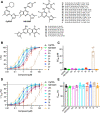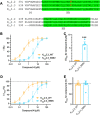Subtype-Selective Positive Modulation of KCa2.3 Channels Increases Cilia Length
- PMID: 35947779
- PMCID: PMC9396613
- DOI: 10.1021/acschembio.2c00469
Subtype-Selective Positive Modulation of KCa2.3 Channels Increases Cilia Length
Abstract
Small-conductance Ca2+-activated potassium (KCa2.x) channels are gated exclusively by intracellular Ca2+. The activation of KCa2.3 channels induces hyperpolarization, which augments Ca2+ signaling in endothelial cells. Cilia are specialized Ca2+ signaling compartments. Here, we identified compound 4 that potentiates human KCa2.3 channels selectively. The subtype selectivity of compound 4 for human KCa2.3 over rat KCa2.2a channels relies on an isoleucine residue in the HA/HB helices. Positive modulation of KCa2.3 channels by compound 4 increased flow-induced Ca2+ signaling and cilia length, while negative modulation by AP14145 reduced flow-induced Ca2+ signaling and cilia length. These findings were corroborated by the increased cilia length due to the expression of Ca2+-hypersensitive KCa2.3_G351D mutant channels and the reduced cilia length resulting from the expression of Ca2+-hyposensitive KCa2.3_I438N channels. Collectively, we were able to associate functions of KCa2.3 channels and cilia, two crucial components in the flow-induced Ca2+ signaling of endothelial cells, with potential implications in vasodilation and ciliopathic hypertension.
Conflict of interest statement
The authors declare no competing financial interest.
Figures






Similar articles
-
Endothelial KCa3.1 and KCa2.3 Mediate S1P (Sphingosine-1-Phosphate)-Dependent Vasodilation and Blood Pressure Homeostasis.Arterioscler Thromb Vasc Biol. 2023 May;43(5):726-738. doi: 10.1161/ATVBAHA.122.318820. Epub 2023 Mar 23. Arterioscler Thromb Vasc Biol. 2023. PMID: 36951065
-
Channelopathy-causing mutations in the S45A/S45B and HA/HB helices of KCa2.3 and KCa3.1 channels alter their apparent Ca2+ sensitivity.Cell Calcium. 2022 Mar;102:102538. doi: 10.1016/j.ceca.2022.102538. Epub 2022 Jan 8. Cell Calcium. 2022. PMID: 35030515 Free PMC article.
-
Laminar shear stress upregulates endothelial Ca²⁺-activated K⁺ channels KCa2.3 and KCa3.1 via a Ca²⁺/calmodulin-dependent protein kinase kinase/Akt/p300 cascade.Am J Physiol Heart Circ Physiol. 2013 Aug 15;305(4):H484-93. doi: 10.1152/ajpheart.00642.2012. Epub 2013 Jun 21. Am J Physiol Heart Circ Physiol. 2013. PMID: 23792675 Free PMC article.
-
Channelopathy of small- and intermediate-conductance Ca2+-activated K+ channels.Acta Pharmacol Sin. 2023 Feb;44(2):259-267. doi: 10.1038/s41401-022-00935-1. Epub 2022 Jun 17. Acta Pharmacol Sin. 2023. PMID: 35715699 Free PMC article. Review.
-
Pharmacology of Small- and Intermediate-Conductance Calcium-Activated Potassium Channels.Annu Rev Pharmacol Toxicol. 2020 Jan 6;60:219-240. doi: 10.1146/annurev-pharmtox-010919-023420. Epub 2019 Jul 23. Annu Rev Pharmacol Toxicol. 2020. PMID: 31337271 Free PMC article. Review.
Cited by
-
Ca2+-Sensitive Potassium Channels.Molecules. 2023 Jan 16;28(2):885. doi: 10.3390/molecules28020885. Molecules. 2023. PMID: 36677942 Free PMC article. Review.
-
KCa2 and KCa3.1 Channels in the Airways: A New Therapeutic Target.Biomedicines. 2023 Jun 21;11(7):1780. doi: 10.3390/biomedicines11071780. Biomedicines. 2023. PMID: 37509419 Free PMC article. Review.
References
-
- Liu Y.; Xie A.; Singh A. K.; Ehsan A.; Choudhary G.; Dudley S.; Sellke F. W.; Feng J. Inactivation of Endothelial Small/Intermediate Conductance of Calcium-Activated Potassium Channels Contributes to Coronary Arteriolar Dysfunction in Diabetic Patients. J. Am. Heart Assoc. 2015, 4, e00206210.1161/JAHA.115.002062. - DOI - PMC - PubMed
-
- Köhler R.; Degenhardt C.; Kühn M.; Runkel N.; Paul M.; Hoyer J. Expression and function of endothelial Ca(2+)-activated K(+) channels in human mesenteric artery: A single-cell reverse transcriptase-polymerase chain reaction and electrophysiological study in situ. Circ. Res. 2000, 87, 496–503. 10.1161/01.res.87.6.496. - DOI - PubMed
Publication types
MeSH terms
Substances
Grants and funding
LinkOut - more resources
Full Text Sources
Miscellaneous

